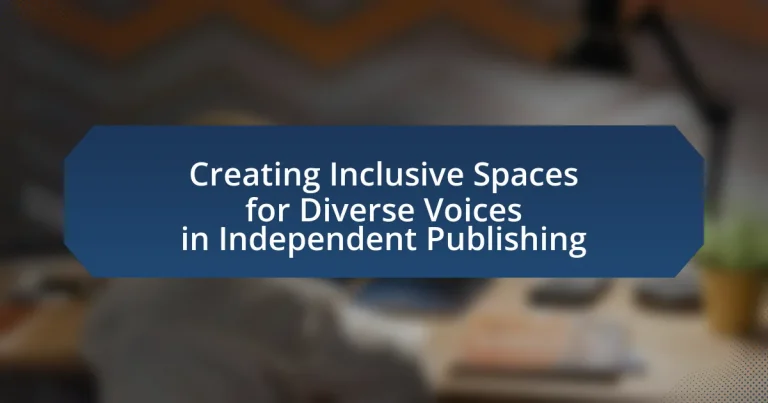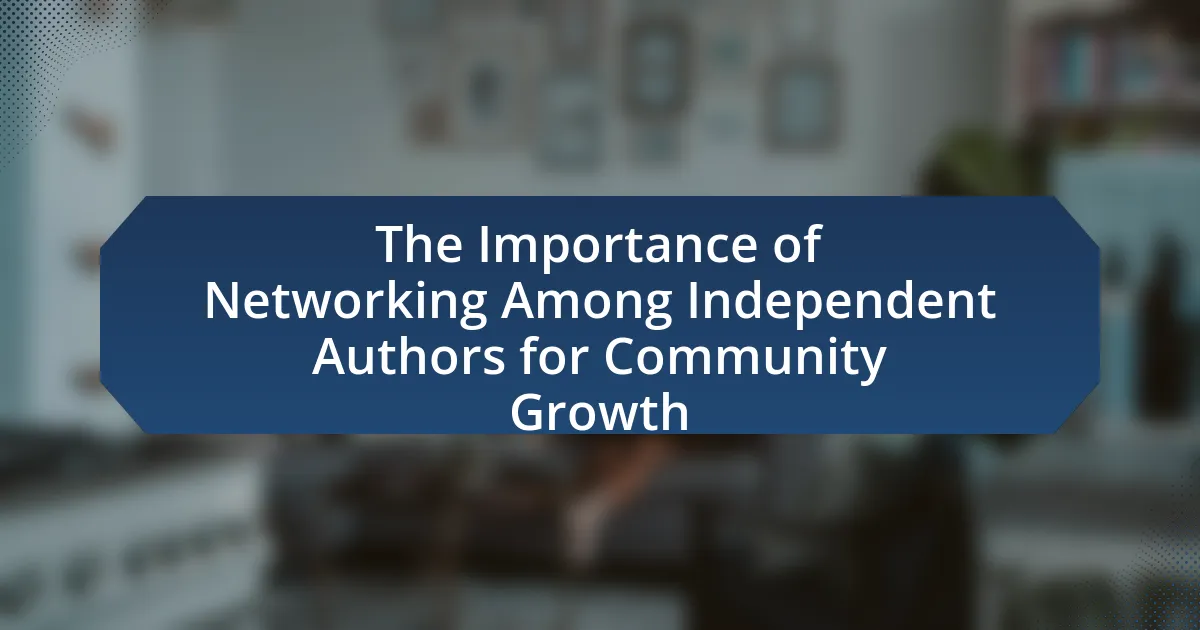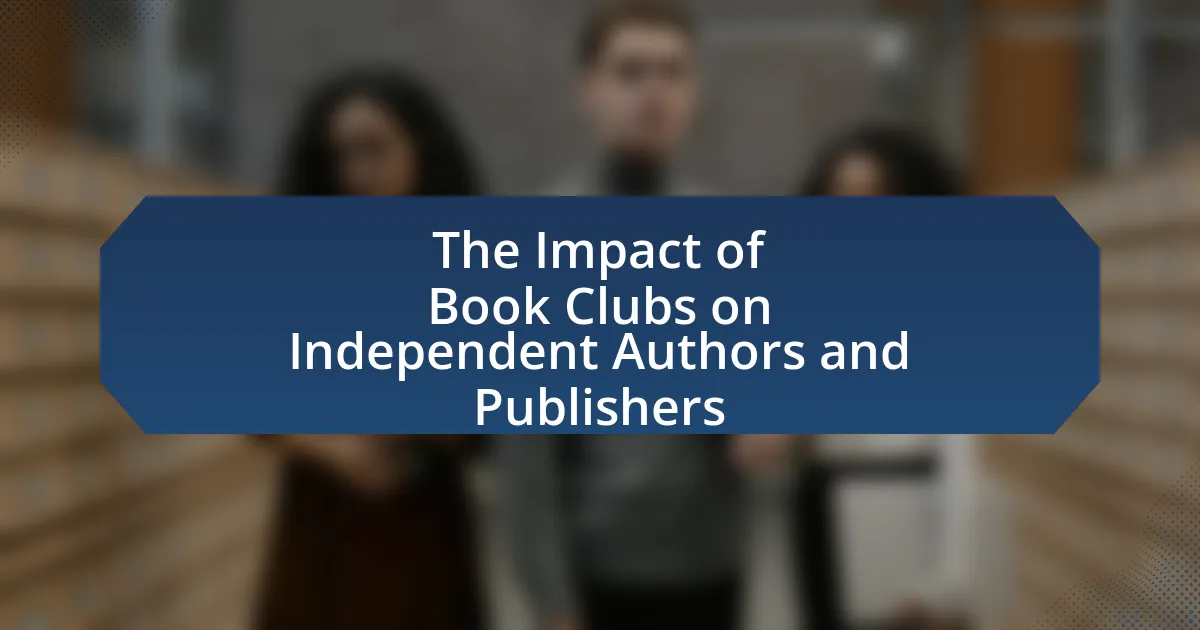Creating inclusive spaces for diverse voices in independent publishing involves fostering an environment where authors from various backgrounds can share their work without barriers. This article explores the importance of inclusivity in enriching the literary landscape, the historical barriers that have hindered representation, and the impact of diverse narratives on empathy and understanding among readers. It also discusses strategies for identifying and supporting marginalized authors, the role of community engagement, and the challenges independent publishers face in promoting inclusivity. Key practices for fostering an inclusive environment, such as diversifying editorial teams and leveraging technology, are highlighted, along with methods for measuring success in these efforts.

What does it mean to create inclusive spaces for diverse voices in independent publishing?
Creating inclusive spaces for diverse voices in independent publishing means fostering an environment where authors from various backgrounds, identities, and experiences can share their work without barriers. This involves actively seeking out and amplifying underrepresented voices, ensuring equitable access to publishing resources, and promoting diverse narratives that reflect the complexity of society. Research indicates that diverse representation in literature not only enriches the cultural landscape but also enhances empathy and understanding among readers, as evidenced by studies showing that exposure to diverse stories can reduce prejudice and increase social cohesion.
Why is inclusivity important in independent publishing?
Inclusivity is important in independent publishing because it ensures diverse voices and perspectives are represented, enriching the literary landscape. By including authors from various backgrounds, independent publishers can challenge dominant narratives and provide readers with a broader understanding of different cultures and experiences. Research indicates that diverse representation in literature can foster empathy and social awareness among readers, as seen in studies like “The Impact of Diverse Literature on Empathy” published in the Journal of Educational Psychology. This highlights that inclusivity not only benefits the authors and their communities but also enhances the reading experience for a wider audience.
What are the historical barriers to inclusivity in publishing?
Historical barriers to inclusivity in publishing include systemic racism, gender bias, and economic disparities. Systemic racism has historically marginalized voices from diverse racial and ethnic backgrounds, limiting their access to publishing opportunities; for instance, the predominance of white authors in mainstream publishing has perpetuated a narrow narrative. Gender bias has also played a significant role, with women and non-binary authors facing challenges in gaining recognition and support, as evidenced by the gender disparity in literary awards and publishing contracts. Additionally, economic disparities have restricted access to publishing resources for underrepresented groups, as the high costs associated with publishing and marketing often favor established authors from privileged backgrounds. These barriers have collectively hindered the representation of diverse voices in the publishing industry.
How does inclusivity impact the quality of published works?
Inclusivity significantly enhances the quality of published works by incorporating diverse perspectives and experiences, which enriches content and broadens its appeal. Research indicates that diverse teams produce more innovative and higher-quality outputs; for instance, a study by McKinsey & Company found that companies in the top quartile for gender diversity on executive teams were 21% more likely to experience above-average profitability. This principle applies to publishing, where inclusive practices lead to a wider range of narratives and ideas, ultimately resulting in more engaging and relatable material for a broader audience.
Who are the diverse voices that should be included?
Diverse voices that should be included in independent publishing encompass individuals from various backgrounds, including but not limited to, authors of different ethnicities, genders, sexual orientations, abilities, and socioeconomic statuses. Specifically, this includes voices from marginalized communities such as Black, Indigenous, and People of Color (BIPOC), LGBTQ+ individuals, people with disabilities, and those from low-income backgrounds. Research indicates that representation in literature enhances empathy and understanding among readers, as highlighted in the 2019 report by the Cooperative Children’s Book Center, which found that only 28% of children’s books published featured BIPOC characters. This underscores the necessity of including a broader spectrum of voices to create a more equitable and representative publishing landscape.
What demographics are often underrepresented in publishing?
Demographics often underrepresented in publishing include people of color, LGBTQ+ individuals, and those from low-income backgrounds. Research indicates that while people of color make up approximately 40% of the U.S. population, they represent only about 20% of published authors. Additionally, LGBTQ+ voices are frequently marginalized, with only a small percentage of books featuring LGBTQ+ characters or themes. Furthermore, individuals from low-income backgrounds face barriers to entry in the publishing industry, limiting their representation. These statistics highlight the significant gaps in diversity within the publishing landscape.
How can we identify and support marginalized authors?
To identify and support marginalized authors, one can utilize targeted outreach and community engagement strategies. Organizations and publishers can actively seek submissions from underrepresented groups by partnering with diverse literary organizations and attending events that focus on marginalized voices. For instance, initiatives like the We Need Diverse Books campaign have successfully highlighted the importance of diverse narratives and provided platforms for marginalized authors. Additionally, offering mentorship programs and workshops specifically designed for these authors can enhance their visibility and professional development, as evidenced by the success of programs like the Voices of Our Nation Arts Foundation, which has supported numerous writers from marginalized backgrounds.
What strategies can be employed to foster inclusivity?
To foster inclusivity in independent publishing, organizations can implement strategies such as diversifying their editorial boards, actively seeking submissions from underrepresented authors, and providing mentorship programs for marginalized voices. Diversifying editorial boards ensures a variety of perspectives in decision-making, which can lead to more inclusive content. Actively seeking submissions from underrepresented authors addresses systemic barriers in publishing, as studies show that diverse authorship leads to a broader range of narratives and experiences being shared. Additionally, mentorship programs can empower marginalized voices by providing guidance and support, which is crucial for navigating the publishing landscape. These strategies collectively create an environment where diverse voices are not only heard but valued.
How can independent publishers create equitable opportunities for all authors?
Independent publishers can create equitable opportunities for all authors by implementing inclusive selection processes and providing resources that support diverse voices. By actively seeking submissions from underrepresented groups and ensuring that their editorial teams reflect a variety of backgrounds, independent publishers can foster a more equitable publishing landscape. Research indicates that diverse teams produce better outcomes, as seen in a 2018 McKinsey report, which found that companies with diverse workforces are 33% more likely to outperform their peers. Additionally, offering mentorship programs and workshops tailored to marginalized authors can help bridge the gap in access to publishing resources, further promoting equity in the industry.
What role does community engagement play in promoting diverse voices?
Community engagement plays a crucial role in promoting diverse voices by facilitating dialogue and collaboration among various groups. This engagement allows marginalized communities to share their narratives, ensuring that a wider range of perspectives is represented in independent publishing. Research indicates that inclusive community engagement initiatives can lead to increased visibility for underrepresented authors, as seen in programs like the Community of Writers, which actively supports diverse literary voices through workshops and mentorship. By fostering an environment where diverse stories are valued and amplified, community engagement directly contributes to a richer, more inclusive literary landscape.
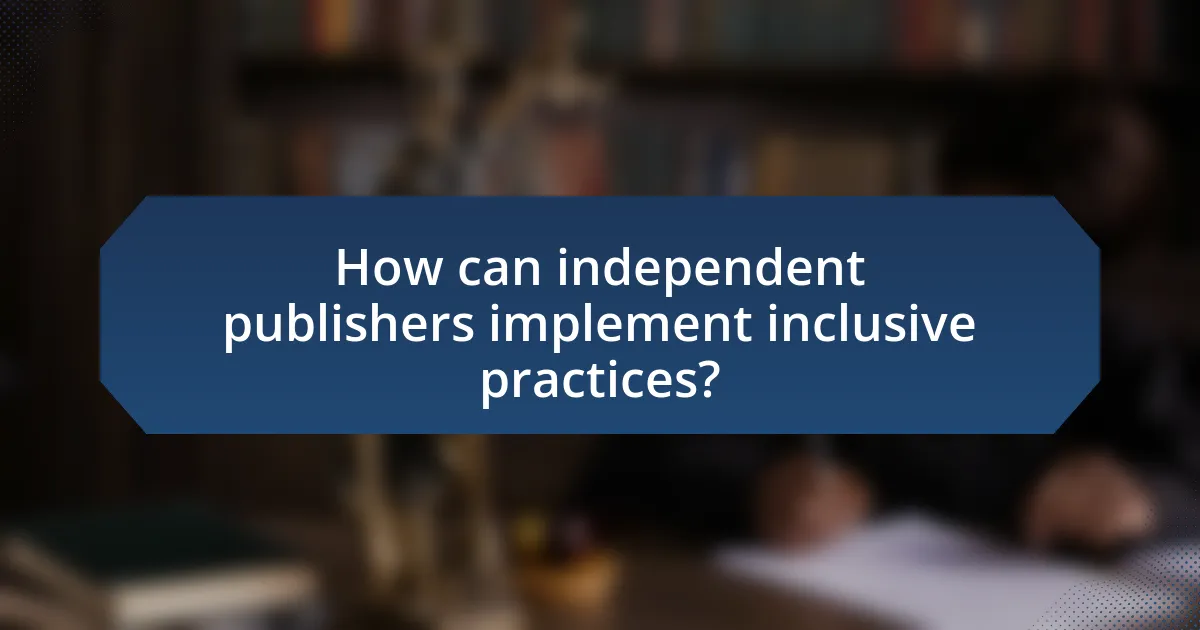
How can independent publishers implement inclusive practices?
Independent publishers can implement inclusive practices by actively seeking diverse voices and perspectives in their publishing processes. This involves establishing partnerships with underrepresented authors, ensuring equitable access to publishing opportunities, and creating a supportive environment that values diverse narratives. Research indicates that diverse teams lead to more innovative outcomes; for instance, a McKinsey report shows that companies in the top quartile for gender diversity are 21% more likely to outperform on profitability. By prioritizing inclusivity, independent publishers not only enrich their catalogs but also contribute to a more equitable literary landscape.
What are the best practices for creating inclusive editorial policies?
The best practices for creating inclusive editorial policies include actively engaging diverse voices in the decision-making process and ensuring representation across all levels of editorial staff. Engaging diverse voices fosters a broader range of perspectives, which enhances the quality and relevance of content. Research shows that organizations with diverse teams are 35% more likely to outperform their peers (McKinsey & Company, 2020). Additionally, implementing clear guidelines that address bias and promote equity in content selection and representation is crucial. These guidelines should be regularly reviewed and updated based on feedback from marginalized communities to ensure they remain effective and relevant.
How can publishers ensure diverse representation in their editorial teams?
Publishers can ensure diverse representation in their editorial teams by actively recruiting from a wide range of backgrounds and experiences. This involves implementing targeted outreach strategies to attract candidates from underrepresented communities, such as partnering with organizations that focus on diversity in publishing. Research indicates that diverse teams lead to more innovative ideas and better decision-making, as highlighted in a McKinsey report which found that companies in the top quartile for ethnic and racial diversity are 35% more likely to outperform their peers in profitability. Additionally, publishers should establish mentorship programs and create an inclusive workplace culture that values diverse perspectives, further enhancing representation and retention within editorial teams.
What training or resources are necessary for staff to promote inclusivity?
Staff training on inclusivity should include workshops on cultural competency, unconscious bias, and effective communication strategies. These workshops equip staff with the skills to understand and respect diverse perspectives, fostering an inclusive environment. Resources such as diversity toolkits, inclusive language guides, and access to mentorship programs further support staff in implementing inclusive practices. Research indicates that organizations with comprehensive diversity training see a 30% increase in employee engagement and a 25% improvement in team collaboration, demonstrating the effectiveness of these training and resources in promoting inclusivity.
How can marketing strategies be adapted to support diverse voices?
Marketing strategies can be adapted to support diverse voices by incorporating inclusive messaging, utilizing diverse representation in campaigns, and engaging with various communities. Inclusive messaging ensures that marketing materials resonate with different cultural backgrounds, while diverse representation in visuals and narratives reflects the audience’s diversity. Engaging with communities through partnerships and feedback mechanisms fosters trust and authenticity, as evidenced by studies showing that brands perceived as inclusive see increased customer loyalty and engagement. For instance, a 2021 report by McKinsey found that companies with diverse leadership teams are 25% more likely to outperform their peers in profitability, highlighting the business case for supporting diverse voices in marketing.
What are effective ways to reach diverse audiences in marketing campaigns?
Effective ways to reach diverse audiences in marketing campaigns include utilizing targeted messaging, leveraging multicultural platforms, and employing inclusive imagery. Targeted messaging ensures that the content resonates with specific cultural values and preferences, which can significantly enhance engagement. For instance, research by the American Marketing Association indicates that culturally relevant marketing can increase brand loyalty by up to 50%. Leveraging multicultural platforms, such as social media channels popular within specific communities, allows brands to connect directly with diverse groups. Additionally, employing inclusive imagery that reflects the diversity of the audience not only fosters relatability but also demonstrates a brand’s commitment to inclusivity, which can improve brand perception and trust.
How can storytelling be used to amplify underrepresented voices?
Storytelling can amplify underrepresented voices by providing a platform for diverse narratives that challenge dominant cultural perspectives. This approach allows marginalized individuals to share their experiences, fostering empathy and understanding among wider audiences. For instance, initiatives like the “We Need Diverse Books” campaign have successfully highlighted the importance of representation in literature, leading to increased visibility for authors from various backgrounds. Research indicates that diverse storytelling not only enriches the literary landscape but also contributes to social change by validating the experiences of those who have historically been silenced.
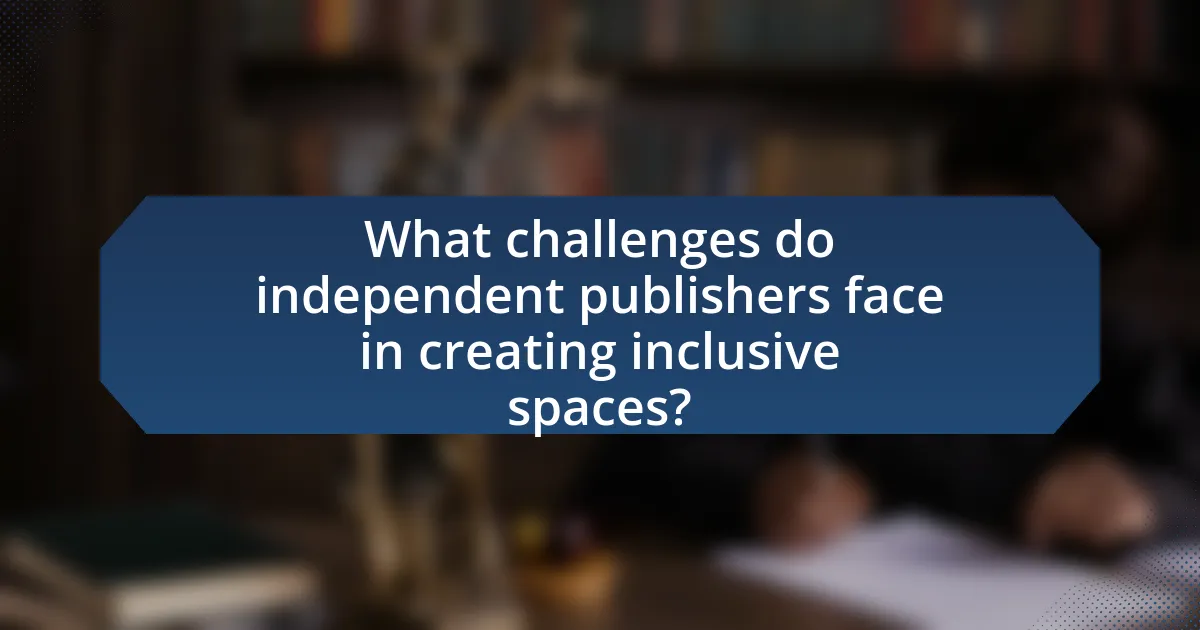
What challenges do independent publishers face in creating inclusive spaces?
Independent publishers face significant challenges in creating inclusive spaces, primarily due to limited financial resources and market reach. These constraints hinder their ability to invest in diverse voices and promote underrepresented authors effectively. For instance, a study by the Cooperative Children’s Book Center revealed that in 2018, only 28% of children’s books published featured characters of color, highlighting the systemic barriers that independent publishers encounter in diversifying their catalogs. Additionally, the lack of established distribution networks further complicates their efforts to reach broader audiences, making it difficult to sustain inclusive initiatives.
What are the common obstacles to inclusivity in independent publishing?
Common obstacles to inclusivity in independent publishing include limited access to resources, lack of representation in decision-making roles, and systemic biases within the industry. Limited access to resources often manifests as financial constraints, which can hinder diverse authors from publishing their work. Additionally, the underrepresentation of marginalized voices in editorial and leadership positions perpetuates a cycle where diverse narratives are overlooked. Systemic biases, such as those related to race, gender, and socioeconomic status, further complicate the landscape, making it challenging for independent publishers to create truly inclusive environments. These factors collectively contribute to a publishing ecosystem that does not fully embrace diversity.
How can financial constraints impact efforts towards inclusivity?
Financial constraints significantly hinder efforts towards inclusivity by limiting resources available for outreach, programming, and support for underrepresented groups. Independent publishing often relies on funding for initiatives that promote diverse voices; without adequate financial backing, these initiatives may be scaled back or eliminated entirely. For instance, a study by the Cooperative Children’s Book Center found that in 2018, only 28% of children’s books published featured characters of color, highlighting the impact of financial limitations on diverse representation in literature. Thus, insufficient funding directly correlates with reduced opportunities for inclusivity in independent publishing.
What resistance might publishers encounter when promoting diverse voices?
Publishers may encounter resistance from established market norms and audience biases when promoting diverse voices. Traditional publishing often prioritizes mainstream narratives that align with dominant cultural perspectives, leading to reluctance in embracing diverse authors. Additionally, some readers may express discomfort or skepticism towards unfamiliar voices, which can result in lower sales and financial risk for publishers. Research indicates that diverse representation in literature can enhance market appeal, yet the initial pushback from conservative audiences often hampers the willingness of publishers to invest in diverse works.
How can these challenges be overcome?
To overcome challenges in creating inclusive spaces for diverse voices in independent publishing, organizations must implement targeted outreach and support initiatives. These initiatives can include mentorship programs that connect emerging authors from underrepresented backgrounds with established industry professionals, thereby fostering skill development and networking opportunities. Research by the Cooperative Children’s Book Center indicates that diverse representation in children’s literature has increased when publishers actively seek out and promote works by authors of color, demonstrating that intentional efforts lead to greater inclusivity. Additionally, establishing funding opportunities specifically for diverse authors can alleviate financial barriers, enabling a broader range of voices to be published.
What collaborative efforts can be made to enhance inclusivity in publishing?
Collaborative efforts to enhance inclusivity in publishing include partnerships between publishers, authors, and diverse community organizations. These collaborations can facilitate mentorship programs that connect emerging writers from underrepresented backgrounds with established authors, fostering skill development and networking opportunities. Additionally, publishers can work with advocacy groups to create inclusive editorial boards that reflect diverse perspectives, ensuring that a variety of voices are represented in decision-making processes. Research indicates that diverse teams produce more innovative content, which can lead to increased readership and market reach. For instance, a study by McKinsey & Company found that companies with greater diversity are 35% more likely to outperform their peers. By actively engaging in these collaborative efforts, the publishing industry can create a more inclusive environment that supports and amplifies diverse voices.
How can independent publishers leverage technology to support diverse voices?
Independent publishers can leverage technology by utilizing digital platforms and social media to amplify diverse voices. These technologies enable publishers to reach wider audiences, allowing marginalized authors to share their stories and perspectives. For instance, platforms like Wattpad and Medium provide accessible avenues for writers from various backgrounds to publish their work without traditional gatekeeping. Additionally, data analytics tools can help publishers identify and promote underrepresented authors, ensuring a more inclusive catalog. Research indicates that diverse representation in literature not only enriches the reading experience but also reflects societal realities, making it essential for independent publishers to embrace these technological advancements.
What practical steps can independent publishers take to create inclusive spaces?
Independent publishers can create inclusive spaces by actively diversifying their author selection and promoting underrepresented voices. This involves implementing targeted outreach programs to identify and support marginalized writers, ensuring that their publishing lists reflect a wide range of perspectives. Research shows that diverse teams lead to better decision-making and innovation, as highlighted in a McKinsey report which found that companies with more diverse workforces perform better financially. Additionally, independent publishers should establish mentorship programs that connect emerging authors from diverse backgrounds with experienced industry professionals, fostering an environment of growth and inclusion. By prioritizing accessibility in their publishing processes, such as offering resources in multiple languages and formats, independent publishers can further enhance inclusivity.
What are some actionable tips for fostering an inclusive publishing environment?
To foster an inclusive publishing environment, organizations should implement diverse hiring practices, ensuring representation across various demographics. Research indicates that diverse teams produce more innovative ideas and solutions, enhancing the overall quality of published works. Additionally, providing training on cultural competency and bias awareness can help staff recognize and mitigate unconscious biases in their editorial processes. Establishing mentorship programs for underrepresented authors can also create pathways for diverse voices to be heard, as evidenced by initiatives like the We Need Diverse Books campaign, which has successfully promoted inclusivity in literature. Lastly, actively seeking feedback from marginalized communities about their publishing experiences can guide improvements and foster a more inclusive atmosphere.
How can independent publishers measure their success in promoting inclusivity?
Independent publishers can measure their success in promoting inclusivity by analyzing diverse representation in their published works and assessing audience engagement metrics. Specifically, they can track the percentage of authors from underrepresented backgrounds they publish, aiming for a balanced representation that reflects societal diversity. Additionally, they can evaluate reader feedback and engagement through surveys and social media interactions, which provide insights into how well their inclusivity efforts resonate with audiences. For instance, a study by the Cooperative Children’s Book Center found that in 2018, only 28% of children’s books featured characters of color, highlighting the need for publishers to actively increase this percentage to demonstrate commitment to inclusivity.
